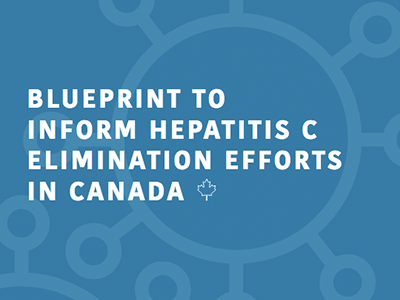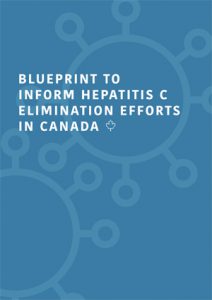Blueprint for Hepatitis C Elimination in Canada: A priority populations and health equity approach – Part One

 An introduction by Dr. Jordan Feld, University Health Network
An introduction by Dr. Jordan Feld, University Health Network
Nearly 250,000 Canadians are living with hepatitis C (HCV), yet 45% are undiagnosed and remain at risk of developing complications related to long-term liver damage like liver cancer. Hepatitis C causes more years of life lost than any other infectious disease in Canada. Fortunately, with the arrival of safe treatment that cures more than 95% of people, combined with simple diagnostic methods and effective prevention strategies, we now have the tools to eliminate hepatitis C.
In 2016, Canada signed on to the World Health Organization’s Global Health Sector Strategy on Viral Hepatitis, with the goal of eliminating viral hepatitis, including hepatitis C, as a public health threat by 2030. But why are we not talking about eradication? Because there is no protective vaccine for hepatitis C and even with one, it may not be possible to completely eradicate it. On the other hand, elimination as a public health threat is possible with a decrease in the prevalence of hepatitis C to very low levels. However, achieving this will require a coordinated public health approach based on concrete actions in prevention, testing and treatment, with ongoing surveillance of the infection.
With this in mind, the Canadian Network on Hepatitis C (CanHepC), a leading network of researchers and experts in hepatitis C, has developed a Blueprint to Inform Hepatitis C Elimination Efforts in Canada to define what needs to be done as a public health response to achieve hepatitis C elimination in Canada. The Blueprint provides a menu of recommendations with specific objectives, time-bound targets, suggested activities and evidence-informed good practices in the areas of prevention, testing and diagnosis, and care and treatment, to achieve elimination by 2030. It aims to guide policy-makers, program planners and service providers from provinces and territories in the development of their own hepatitis C action plans.
The Blueprint focuses on priority populations and health equity in its approach and objectives, providing relevant recommendations for five main populations: people who inject or use drugs, Indigenous people, immigrants and newcomers from countries where hepatitis C is common, people with experience in the prison system, and gay, bisexual and other men who have sex with men. The term priority populations was selected intentionally and is meant to refer to populations and communities across Canada who experience a disproportionate burden of hepatitis C and face challenges in accessing mainstream hepatitis C services and other health and social services. They therefore stand to gain the most from a hepatitis C approach grounded in the principles of health equity. The priority populations approach in the Blueprint will be essential to the success of hepatitis C elimination efforts in Canada.
Here is what some of the key leaders involved in writing and developing these specific priority population recommendations had to say about the Blueprint.
Indigenous people
 By Carrielynn Lund, Canadian Aboriginal AIDS Network (CAAN)
By Carrielynn Lund, Canadian Aboriginal AIDS Network (CAAN)
The Blueprint outlines a response that is sensitive to culture and gender diversity. The Indigenous perspective has been woven into the entire document, responds to several of the Truth and Reconciliation Commission of Canada’s Calls for Action, and includes definitions and explanations of Indigenous-specific terms and contexts. It appropriately allows for community and organizational approaches that reflect the culture and values of different populations. There are clearly stated must-haves regarding the response. Capacity-building is two-way and acknowledges the right to self-determination of Indigenous peoples. The Blueprint also recognizes that people must be free to make their own choices. If implemented, the Blueprint will go a long way in helping people make informed choices and providing support and tools for whatever choice is made. Stigma has and continues to be a primary barrier for people getting tested, getting treated and adhering to treatment. Great effort has been made to destigmatize hepatitis C and to assist others in destigmatizing individually and at the program and service delivery levels.
As a person with lived experience of HCV and extensive experience in health-related program design, delivery and evaluation, I support this strategy wholeheartedly. From the beginning, I have been actively involved in the creation of the strategy and, if the recommendations are embraced, they will have a positive impact towards Canada reaching our elimination goals! It is, however, only possible if the Indigenous response is supported and led by Indigenous peoples. The continued involvement of people with lived experience throughout the implementation and evaluation of the Blueprint is critical to its success.
Immigrants and newcomers from countries where HCV is common
 By Fozia Tanveer, CATIE
By Fozia Tanveer, CATIE
Canadian immigrants and newcomers are an important, and often hidden, key population in Canada’s hepatitis C epidemic. One in three people affected by hepatitis C in Canada is foreign-born, mostly from countries with high rates of hepatitis C. In some immigrant groups, hepatitis C prevalence is higher than in Canada’s general population and the virus is mostly transmitted through medical, dental and surgical procedures.
As someone who works with immigrants and newcomers in Ontario, I am happy that the Blueprint identifies this population as a priority and provides guidance with specific and measurable objectives and actions to achieve hepatitis C elimination by 2030.
The Blueprint stresses the importance of including immigrants and newcomers in provincial and territorial HCV strategies. Some healthcare providers might not be aware of the countries where hepatitis C is common, so it’s very important to educate nurses, family doctors and other frontline workers about who is at risk and how they can offer linguistically and culturally appropriate services. The right tools are out there, we just need to make sure service providers are aware of them.
The Blueprint recommends that HCV information, referrals and voluntary testing should be part of the standard newcomer primary health screening. To make testing and treatment more accessible, it should be integrated into multidisciplinary, community-based models of primary care.
All healthcare providers who treat people from countries where HCV is common should be talking about hepatitis C prevention and testing with their clients. The Blueprint explicitly calls for more education among healthcare practitioners, giving practical policy and service delivery recommendations so early detection and treatment of hepatitis C can happen.
This blog post is part one of two. In part two, we will hear from service providers who work with people who use drugs and people with experience in the prison system.
